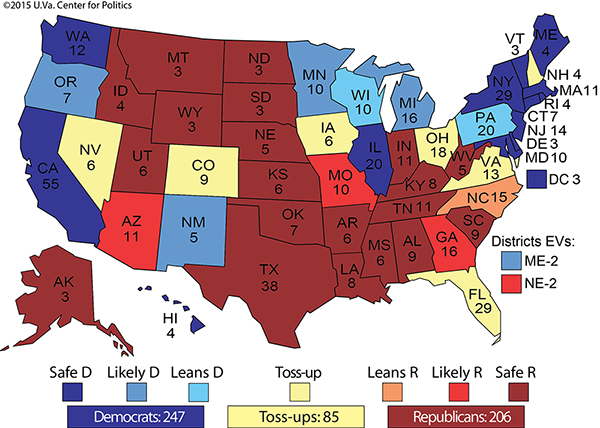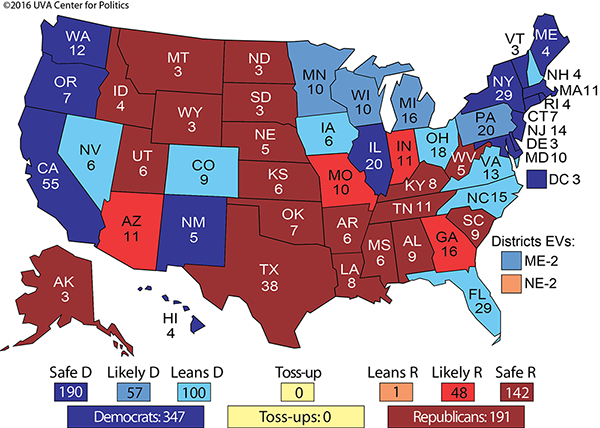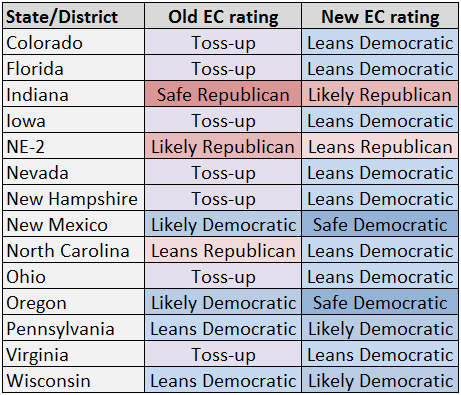The Electoral College: The Only Thing That Matters
A Commentary By Larry J. Sabato, Kyle Kondik and Geoffrey Skelley
It’s a long way to November, but for the moment the GOP is an underdog
We live in a post-factual era. Thanks to the Internet and social media, which mix informed and uninformed views in equal measure, the old rule — that people are entitled to their own opinions but not their own set of facts — no longer applies. Somewhere in cyberspace, you can now find blogs and treatises with “facts” that support your opinions, no matter how bizarre.
Here at the Crystal Ball, though, we are going to cling to one central fact about presidential elections: The only thing that matters is accumulating a majority of 270 votes in the Electoral College.
Creating Electoral College projections is a marvelous parlor game, and we’ve been doing so here since we obtained our magical sphere of crystal from China many years ago. (All other details shall remain confidential.)
We’re now at the point in the nominating process where it is, er, crystal clear that Hillary Clinton will end up being the Democratic candidate, and Donald Trump, while not at all the certain winner, is the leading candidate to become the Republican nominee. So it’s time to adjust our 2016 electoral map for the first time since we rolled out our initial ratings last May. That map, shown below as Map 1, reflected a generic Democrat versus Republican matchup, and it depicted a close, competitive general election.
Map 1: First version of Crystal Ball 2016 Electoral College ratings, May 2015
The new map, as you will see, does not show a close and competitive general election. The Republicans now find themselves in a deep hole.
Yes, more than seven long months remain until the election, and all kinds of unexpected twists and turns can occur. Sure, we don’t know the shape of the economy or terrorism, or the precise job approval rating of President Obama in the autumn, or the gaffes and scandals that may yet unfold on our way to the ballot box. But goshdarnit, there’s finally a pause in the non-stop primary calendar, and we’re going to take advantage of that!
Our new map is one that will evolve, maybe substantially, after the conventions. Remember that independent and/or third-party candidates could change the calculus. Nonetheless, here is our extra-early, ridiculously premature projection of the Electoral College map in a possible Hillary Clinton-Donald Trump matchup. Yielding completely to boldness, or recklessness, we eliminated Toss-ups, and leaned all states to one or the other nominee. Each state’s electoral history, developing demographics, and current polling data guided our choices.
Map 2: Revised Crystal Ball 2016 Electoral College ratings for a Clinton vs. Trump matchup
Table 1: Crystal Ball 2016 Electoral College rating changes
Election analysts prefer close elections, but there was nothing we could do to make this one close. Clinton’s total is 347 electoral votes, which includes 190 safe, 57 likely, and 100 that lean in her direction. Trump has a total of 191 (142 safe, 48 likely, and 1 leans).
Over the years we’ve put much emphasis on the seven super-swing states: Colorado, Florida, Iowa, Nevada, New Hampshire, Ohio, and Virginia. While some will fall to the Democrats less readily than others, it is difficult to see any that Trump is likely to grab. In fact, four normally Republican states (Arizona, Georgia, Indiana, and Missouri) would be somewhat less secure for the GOP than usual. North Carolina, which normally leans slightly to the GOP, would also be well within Clinton’s grasp in this election after being Mitt Romney’s closest win in 2012.
The probability is that the Clinton campaign will target at least one or two of the four Likely Republican states, which would have the effect of helping Democratic Senate nominees where they exist (all of those states have Senate races in November). Because Clinton’s objectives will surely include recapture of the Senate, no doubt her campaign will keep in mind the competitive contests that could yield the net four seats for a tied Senate or five seats for outright Democratic control.
Our belief is that, given the high level of party polarization existing in 2016, the election wouldn’t necessarily resemble the massive landslides of 1964 (Lyndon Johnson-Barry Goldwater) or 1972 (Richard Nixon-George McGovern). Instead of the winner topping 60% as in 1964 and 1972, it is more likely Clinton would garner less than 55% of the two-party vote.
Another assumption is that current polls in some states, such as Utah, that (stunningly) show a tight Clinton-Trump contest are not representative of the conditions we’ll find in the fall. While the GOP defection rate would likely be higher than the usual 10% or so, it wouldn’t be as mountainous as some current surveys suggest. In Utah, the GOP candidate for the White House sometimes receives over 70% of the vote; that’s a lot of votes to be frittered away before a Democrat could win, and LBJ was the last to do so in 1964. Party identification will assert itself for millions of Republicans across the nation, and all or virtually all states with a vast GOP advantage will end up going Republican by some margin. Perhaps a different Democratic nominee would have more crossover appeal, but we have to remember how much Republicans dislike Hillary Clinton.
Polls may be ephemeral and sometimes wildly inaccurate, yet surveys (and demographics) are the only hard data we have this far out from the election. The polling averages for a Clinton-Trump face-off show roughly a 10 percentage point lead for the Democrat. RealClearPolitics has Clinton up about 11 points and HuffPost Pollster gives Clinton a lead of about nine points. This kind of Democratic advantage, if properly distributed, would produce an Electoral College result similar to, or greater than, Barack Obama’s 2008 total of 365 electoral votes to John McCain’s 173 (Obama won the national popular vote by 7.3 points). Again, this suggests that one or more states currently rated Likely Republican (Arizona, Georgia, Indiana, and Missouri) might slip into the Democratic column.
Trump supporters and some independent analysts assert that his appeal to many blue-collar whites in Rust Belt states (such as Michigan, Ohio, Pennsylvania, and Wisconsin) could pull these states’ electoral votes into the Republican column. The problem is, there is little evidence that the non-college voters supporting Trump in the primaries are defectors from the Democrats; most have been backing GOP candidates fairly consistently, so the net addition for Trump could be small. Nor do we buy the theory that increased Republican primary turnout this year means Trump is going to bring out millions more white and primarily male voters that weren’t excited by John McCain in 2008 and Mitt Romney in 2012. Maybe there will be higher white male voter participation, but there will probably be augmented, heavily Democratic minority turnout to balance it. Additionally, some white voters, particularly those with higher incomes and levels of education who may have voted for Romney, might have a hard time pulling the lever for Trump.
Now, let’s suppose the Republican nominee is Ted Cruz and not Donald Trump. How much difference would it make in November? Probably, a Clinton-Cruz contest would be closer. RealClearPolitics’ polling average has Clinton defeating Cruz by about three points, while HuffPost’s average has Clinton winning by about four points. Unquestionably, Cruz would have a better chance of overcoming a gap of three or four points than Trump would of bridging a 10 or 11-point difference. At the least, Cruz could firm up the GOP’s chances in Arizona, Georgia, Indiana, and Missouri, and he could turn some of our Leans Democratic states back into Toss-ups.
At the same time, Cruz is well to the right of recent Republican presidential nominees and disliked greatly by many elected GOP officials. Moreover, goaded by Trump, Cruz has made some extreme statements on immigration and other topics that are sure to stimulate minority participation in November. In some ways, Democrats might have an easier time attacking him: Cruz is a much more vocal social conservative, for instance, which plays right into the standard Democratic playbook of going after Republicans on issues such as abortion and same-sex marriage. However, after Trump suggested Wednesday that women who have abortions should face legal consequences — and then backtracked — it may be that Democrats would have an easy time attacking him on these social issues, too.
Most important of all, the national Republican Party appears certain to remain deeply divided, whether Trump or Cruz is the nominee. If the prize is taken from Trump via convention maneuvering when he has by far the most delegates and is reasonably close to a majority (1,237 delegates), a sizable percentage of Trump voters could defect to a third-party ticket or sit out the election. If Trump wins the Republican crown, we would also expect a considerable chunk of GOP voters to go elsewhere on the ballot, or go fishing entirely on Election Day.
Thus, it could be the nightmare scenario for the party of Lincoln: Heads you lose, tails you lose.
The irony is that Hillary Clinton is a beatable candidate. She has unique vulnerabilities, many a product of being shopworn after a quarter-century of public controversies. Other Republican candidates, had they been the party standard-bearer (such as John Kasich or Marco Rubio), might well have started as the frontrunner. But Rubio is long gone, and Kasich is far behind Trump and Cruz — with no credible pathway to the nomination that we’ve heard. If either is selected as the vice presidential nominee, it will not fundamentally change the election picture. VP candidates almost never do.
Every now and then, one of the major parties goes off the track and forfeits an election, as in 1964 and 1972. This time, it is possible that the Republicans are the new Whigs, headed for a crackup, an oft-made comparison that historian Michael Holt recently examined in the Crystal Ball.
However, it’s just as possible, maybe probable, that the party would repair itself by 2020. Four years after the Goldwater debacle, the Republicans elected a president. Four years after the McGovern disaster, the Democrats elected a president. Odds are, there will be no need for a bugler playing taps for the GOP this time either. Somehow, though, Republicans will have to find ways to heal the deep rifts in their party, while becoming more mainstream and accommodating to this century’s American electorate. It will take far more than another “autopsy report” like the one in 2013 to accomplish this.
If you’re unhappy with this projection of November’s results, dear reader, just wait a while. No analyst that we know correctly predicted the GOP nominating battle. Why should the general election be any different? The roller coaster of 2016 will lead to revisions — perhaps massive — in this, our Electoral College map. Expect new calculations at regular intervals in this exceptionally unpredictable campaign.
However, our first update in 2016 does reflect that the GOP primary battle has made the Republicans general election underdogs. They are not unquestionably doomed to this fate: If we were totally confident about the November outcome, we’d call Florida, Ohio, and the other swing states “safe” for Democrats instead of just leaning them. So there is a long way to go, and after the rise of Trump we’re not even close to 100% confident of much of anything. But a general election race that at the start of the cycle looked like a Toss-up just isn’t right now, which is why we have made such dramatic changes to our ratings.
Larry J. Sabato is the director of the Center for Politics at the University of Virginia.
Kyle Kondik is a Political Analyst at the Center for Politics at the University of Virginia.
Geoffrey Skelley is the Associate Editor at the Center for Politics at the University of Virginia.
See Other Political Commentary by Larry Sabato
See Other Political Commentary by Kyle Kondik
See Other Political Commentary by Geoffrey Skelley
See Other Political Commentary
Rasmussen Reports is a media company specializing in the collection, publication and distribution of public opinion information.
We conduct public opinion polls on a variety of topics to inform our audience on events in the news and other topics of interest. To ensure editorial control and independence, we pay for the polls ourselves and generate revenue through the sale of subscriptions, sponsorships, and advertising. Nightly polling on politics, business and lifestyle topics provides the content to update the Rasmussen Reports web site many times each day. If it's in the news, it's in our polls. Additionally, the data drives a daily update newsletter and various media outlets across the country.
Some information, including the Rasmussen Reports daily Presidential Tracking Poll and commentaries are available for free to the general public. Subscriptions are available for $4.95 a month or 34.95 a year that provide subscribers with exclusive access to more than 20 stories per week on upcoming elections, consumer confidence, and issues that affect us all. For those who are really into the numbers, Platinum Members can review demographic crosstabs and a full history of our data.
To learn more about our methodology, click here.



